stop start BUICK REGAL 1998 User Guide
[x] Cancel search | Manufacturer: BUICK, Model Year: 1998, Model line: REGAL, Model: BUICK REGAL 1998Pages: 388, PDF Size: 20.19 MB
Page 177 of 388
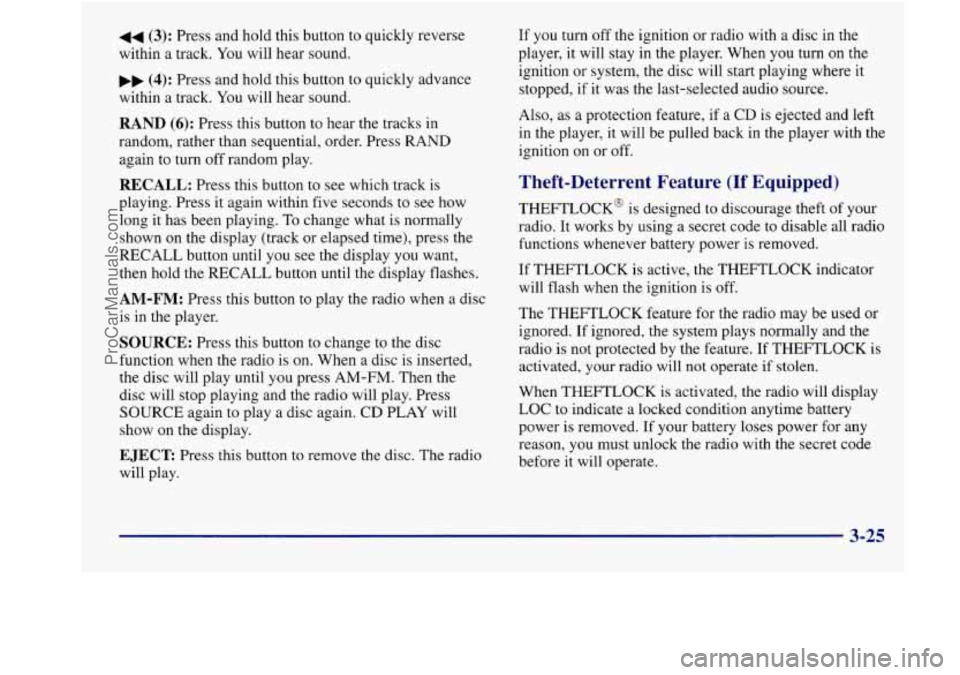
44 (3): Press and hold this button to quickly reverse
within a track. You will hear sound.
.. (4): Press and hold this button to quickly advance
within a track. You will hear sound.
RAND (6): Press this button to hear the tracks in
random, rather than sequential, order. Press
RAND
again to turn off random play.
RECALL: Press this button to see which track is
playing. Press it again within five seconds to see how
long it has been playing.
To change what is normally
shown on the display (track or elapsed time), press the
RECALL button until you see the display you want,
then hold the
RECALL button until the display flashes.
AM-FM: Press this button to play the radio when a disc
is in the player.
SOURCE: Press this button to change to the disc
function when the radio is on. When a disc
is inserted,
the disc will play until you press AM-FM. Then the
disc will stop playing and the radio will play. Press
SOURCE again to play a disc again. CD PLAY will
show on the display.
EJECT Press this button to remove the disc. The radio
will play. If you
turn off the ignition or radio with a disc in the
player, it will stay in the player. When you turn
on the
ignition or system, the disc will start playing where it
stopped, if it was the last-selected audio source.
Also, as a protection feature, if a CD is ejected and left
in the player, it will be pulled back in the player with the
ignition on
or off.
Theft-Deterrent Feature (If Equipped)
THEFTLOCK@ is designed to discourage theft of your
radio. It works by using a secret code
to disable all radio
functions whenever battery power is removed.
If THEFTLOCK is active, the THEFTLOCK indicator
will flash when the ignition is off.
The THEFTLOCK feature for the radio may be used or
ignored. If ignored, the system plays normally and the
radio is not protected by the feature. If THEFTLOCK is
activated, your radio will not operate if stolen.
When THEFTLOCK is activated, the radio will display
LOC to indicate a locked condition anytime battery
power is removed. If your battery loses power for any
reason, you must unlock the radio with
the secret code
before it will operate.
3-25
ProCarManuals.com
Page 191 of 388
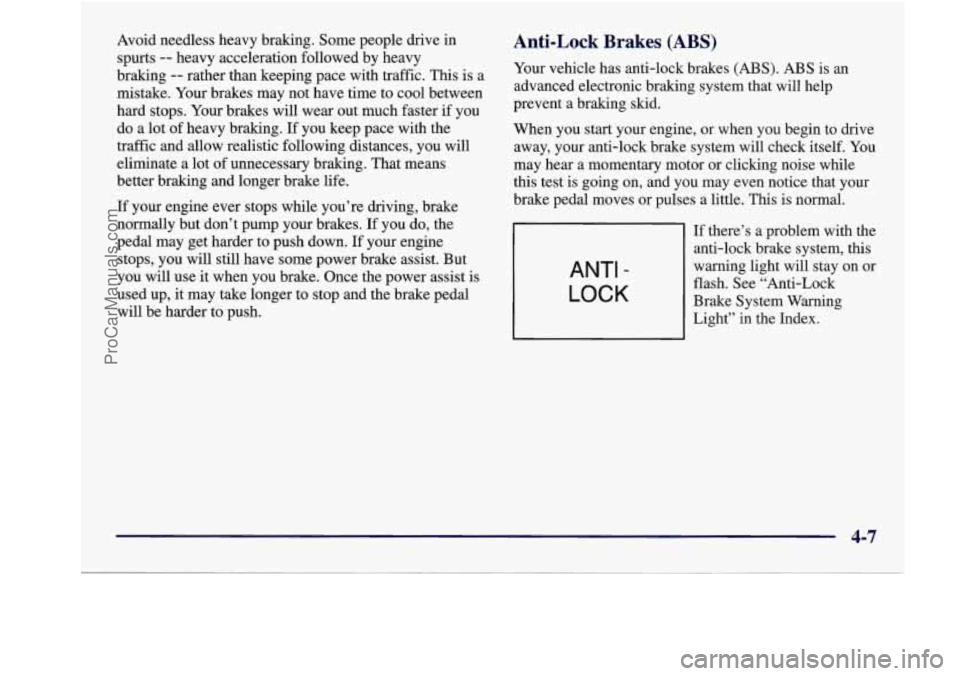
Avoid needless heavy braking. Some people drive in
spurts
-- heavy acceleration followed by heavy
braking
-- rather than keeping pace with traffic. This is a
mistake. Your brakes may not have time to cool between
hard stops. Your brakes will wear out much faster
if you
do a lot of heavy braking. If you keep pace with the
traffic and allow realistic following distances, you will
eliminate a lot of unnecessary braking. That means
better braking and longer brake life.
If your engine ever stops while you’re driving, brake
normally but don’t pump your brakes.
If you do, the
pedal may get harder to push down.
If your engine
stops, you will still have some power brake assist. But
you will use
it when you brake. Once the power assist is
used up,
it may take longer to stop and the brake pedal
will be harder to push.
Anti-Lock Brakes (ABS)
Your vehicle has anti-lock brakes (ABS). ABS is an
advanced electronic braking system that will help
prevent a braking skid.
When you start your engine, or when you begin to drive
away, your anti-lock brake system will check itself. You
may hear a momentary motor or clicking noise while
this test
is going on, and you may even notice that your
brake pedal moves or pulses a little. This is normal.
ANTI -
LOCK
If there’s a problem with the
anti-lock brake system, this
warning light will stay on or
flash. See “Anti-Lock
Brake System Warning
Light”
in the Index.
4-7
ProCarManuals.com
Page 199 of 388
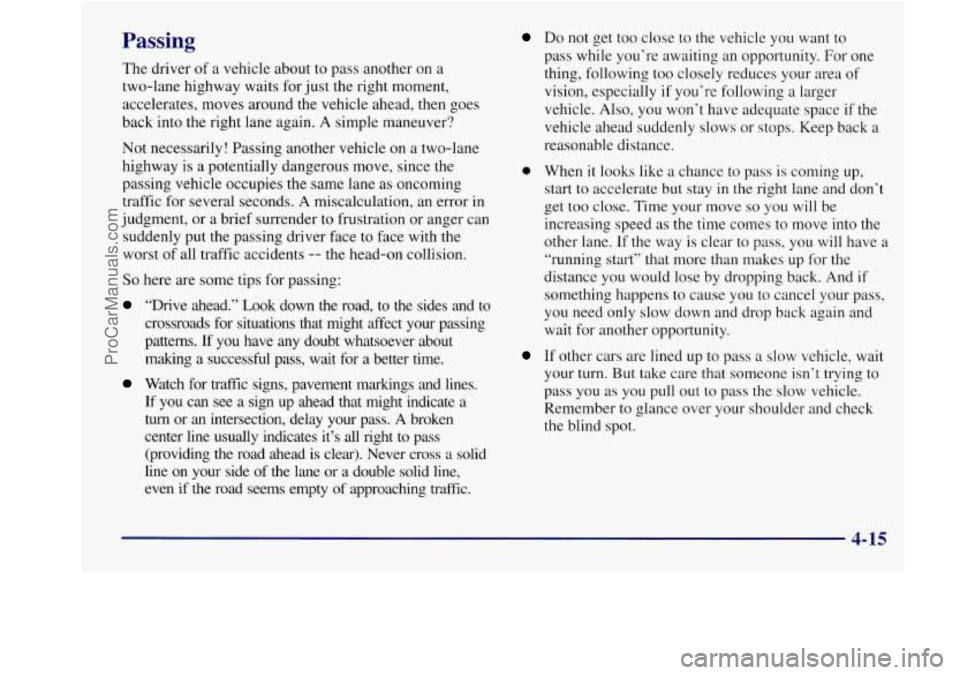
Passing
The driver of a vehicle about to pass another on a
two-lane highway waits for just the right moment,
accelerates, moves around the vehicle ahead, then goes
back into the right lane again. A simple maneuver?
Not necessarily! Passing another vehicle
on a two-lane
highway is a potentially dangerous move, since the
passing vehicle occupies the same lane as oncoming
traffic for several seconds.
A miscalculation, an error in
judgment, or a brief surrender to frustration or anger can
suddenly put the passing driver face to face with the
worst
of all traffic accidents -- the head-on collision.
So here are some tips for passing:
“Drive ahead.” Look down the road, to the sides and to
crossroads for situations that might affect your passing
patterns.
If you have any doubt whatsoever about
malung a successful pass, wait for a better time.
Watch for traffic signs, pavement markings and lines.
If you can see
a sign up ahead that might indicate a
turn or an intersection, delay your pass.
A broken
center line usually indicates it’s all right
to pass
(providing the road ahead is clear). Never cross
a solid
line
on your side of the lane or a double solid line,
even if the road seems empty of approaching traffic.
Do not get too close to the vehicle you want to
pass while you’re awaiting an opportunity. For one
thing, following too closely reduces your area of
vision, especially if you’re following a larger
vehicle. Also, you won’t have adequate space if the
vehicle ahead suddenly slows or stops. Keep back a
reasonable distance.
0 When it looks like a chance to pass is coming up,
start to accelerate but stay
in the right lane and don’t
get
too close. Time your move so you will be
increasing speed
as the time comes to move into the
other lane.
If the way is clear to pass, you will have a
“running start” that more than makes up for the
distance you would lose by dropping back. And
if
something happens to cause you to cancel your pass,
you need only slow down and drop back again and
wait for another opportunity.
If other cars are lined up to pass a slow vehicle, wait
your turn. But take care that someone isn’t trying to
pass you as
you pull out to pass the slow vehicle.
Remember to glance over your shoulder and check
the blind spot.
4-15
ProCarManuals.com
Page 203 of 388
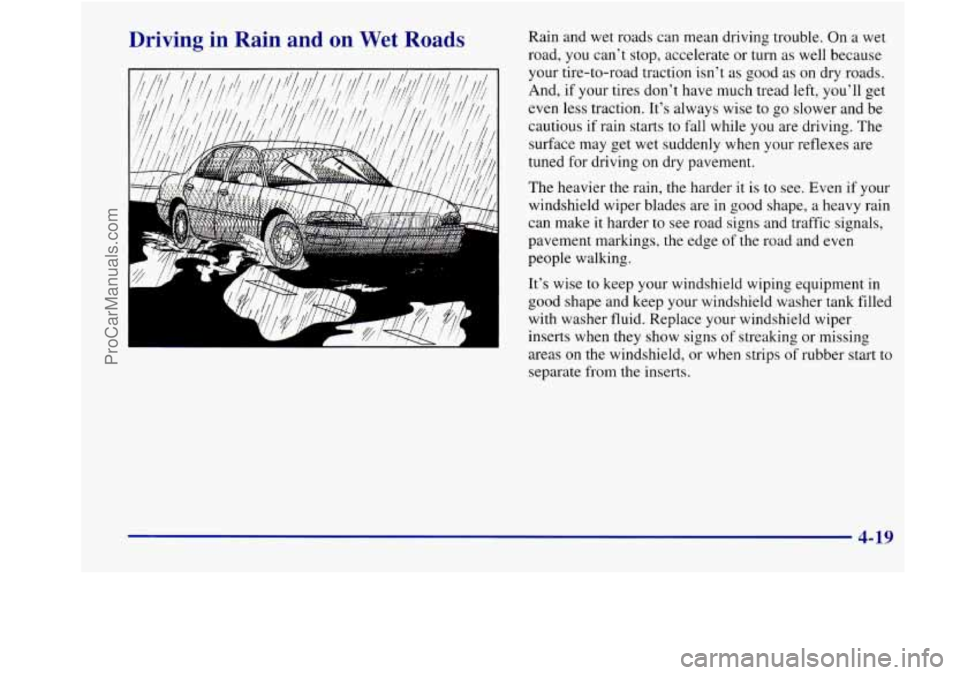
Driving in Rain and on Wet Roads
I-
B
Rain and wet roads can mean driving trouble. On a wet
road, you can’t stop, accelerate or turn as well because
your tire-to-road traction isn’t as good as on dry roads.
And, if your tires don’t have much tread left, you’ll get
even less traction.
It’s always wise to go slower and be
cautious if rain starts
to fall while you are driving. The
surface may get wet suddenly when your reflexes are
tuned for driving on dry pavement.
The heavier the rain, the harder it is to see. Even if your
windshield wiper blades are in good shape, a heavy rain
can make
it harder to see road signs and traffic signals,
pavement markings, the edge of the road and even
people walking.
It’s wise to keep your windshield wiping equipment in
good shape and keep your windshield washer tank filled
with washer fluid. Replace your windshield wiper
inserts when they show signs of streaking or missing
areas on the windshield, or when strips
of rubber start to
separate
from the inserts.
4-19
ProCarManuals.com
Page 223 of 388

Making Thns
I NOTICE:
Making very sharp turns while trailering could
cause the trailer
to come in contact with the
vehicle. Your vehicle could be damaged. Avoid
making very
sharp turns while trailering.
When you’re turning with a trailer, make wider
turns than normal.
Do this so your trailer won’t strike
soft shoulders, curbs, road signs, trees or other objects.
Avoid jerky or sudden maneuvers. Signal well
in advance.
Turn Signals When Towing a Trailer
When you tow a trailer, your vehicle may need a
different turn signal flasher and/or extra wiring. Check
with your Buick dealer. The green arrows on your
instrument panel will flash whenever you signal a turn
or lane change. Properly hooked up, the trailer lamps
will also flash, telling other drivers you’re about to turn,
change lanes
or stop.
When towing
a trailer, the green arrows on your
instrument panel will flash for turns even
if the bulbs on
the trailer are burned out. Thus, you may think drivers
behind you are seeing your signal when they are not. It’s
important to check occasionally to be sure the trailer
bulbs are still working.
Driving On Grades
Reduce speed and shift to a lower gear before you start
down
a long or steep downgrade. If you don‘t shift
down, you might have to use your brakes
so much that
they would get hot and no longer work well.
On
a long uphill grade, shift down and reduce your
speed to around
45 mph (70 km/h) to reduce the
possibility
of engine and transaxle overheating.
4-39
ProCarManuals.com
Page 224 of 388
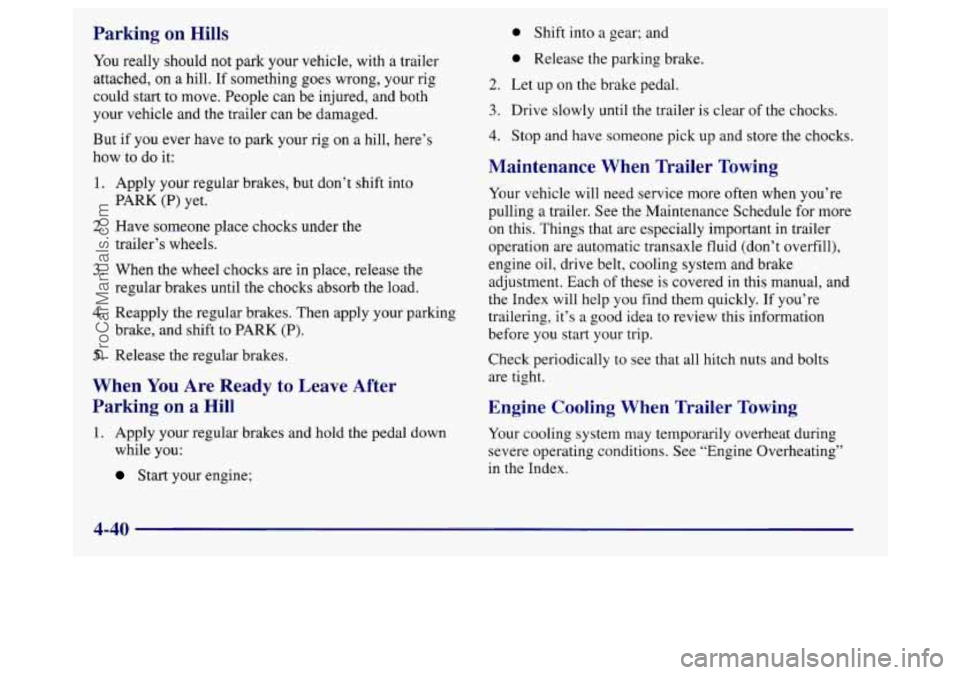
Parking on Hills 0 Shift into a gear; and
0 Release the parking brake.
You really should not park your vehicle, with a trailer
attached, on
a hill. If something goes wrong, your rig
could start to move. People can be injured, and both
your vehicle and the trailer can be damaged.
But if you ever have to park your rig on a hill, here’s
how to do it:
1. Apply your regular brakes, but don’t shift into
PARK (P) yet.
2. Have someone place chocks under the
trailer’s wheels.
3. When the wheel chocks are in place, release the
regular brakes until the chocks absorb the load.
4. Reapply the regular brakes. Then apply your parking
brake, and shift to
PARK (P).
5. Release the regular brakes.
When You Are Ready to Leave After
Parking
on a Hill
1. Apply your regular brakes and hold the pedal down
while you:
Start your engine;
2. Let up on the brake pedal.
3. Drive slowly until the trailer is clear of the chocks.
4. Stop and have someone pick up and store the chocks.
Maintenance When Trailer Towing
Your vehicle will need service more often when you’re
pulling a trailer. See the Maintenance Schedule for more
on this. Things that are especially important in trailer
operation are automatic transaxle fluid (don’t overfill),
engine oil, drive belt, cooling system and brake
adjustment. Each of these
is covered in this manual, and
the Index
will help you find them quickly. If you’re
trailering, it’s a good idea to review this information
before you start your trip.
Check periodically
to see that all hitch nuts and bolts
are tight.
Engine Cooling When Trailer Towing
Your cooling system may temporarily overheat during
severe operating conditions. See “Engine Overheating”
in the Index.
4-40
ProCarManuals.com
Page 327 of 388
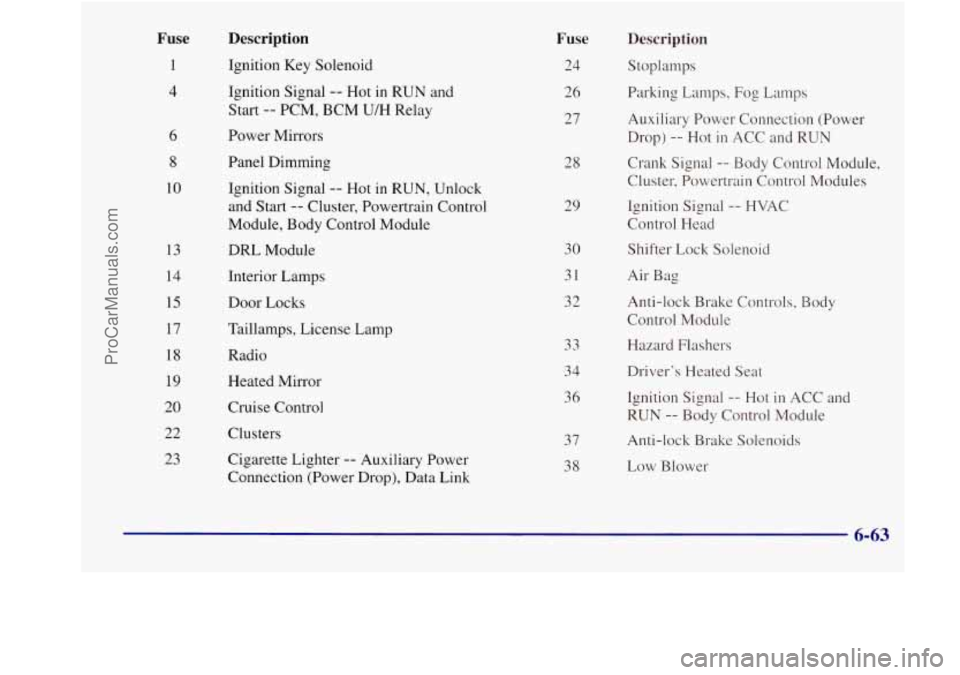
Fuse
1
4
6
8
10
13
14
15
17
18
19
20
22
23
Description
Ignition Key Solenoid
Ignition Signal
-- Hot in RUN and
Start
-- PCM, BCM U/H Relay
Power Mirrors
Panel Dimming
Ignition Signal
-- Hot in RUN, Unlock
and Start
-- Cluster, Powertrain Control
Module, Body Control Module
DRL Module
Interior Lamps
Door
Locks
Taillamps, License Lamp
Radio
Heated Mirror
Cruise Control
Clusters
Cigarette Lighter
-- Auxiliary Power
Connection (Power Drop), Data Link
Fuse
24
26
27
28
29
30
31
32
33
34
36
37
38
Description
Stoplamps
Parking Lamps,
Fog Lamps
Auxiliary Power Connection (Power
Drop)
-- Hot in ACC and RUN
Crank Signal
-- Body Control Module,
Cluster, Powertrain Control Modules
Ignition Signal
-- HVAC
Control Head
Shifter Lock Solenoid
Air Bag
Anti-lock Brake Controls, Body
Control Module
Hazard Flashers
Driver’s Heated Seat
Ignition Signal
-- Hot in ACC and
RUN
-- Body Control Module
Anti-lock Brake Solenoids
Low Blower
6-63
ProCarManuals.com
Page 329 of 388
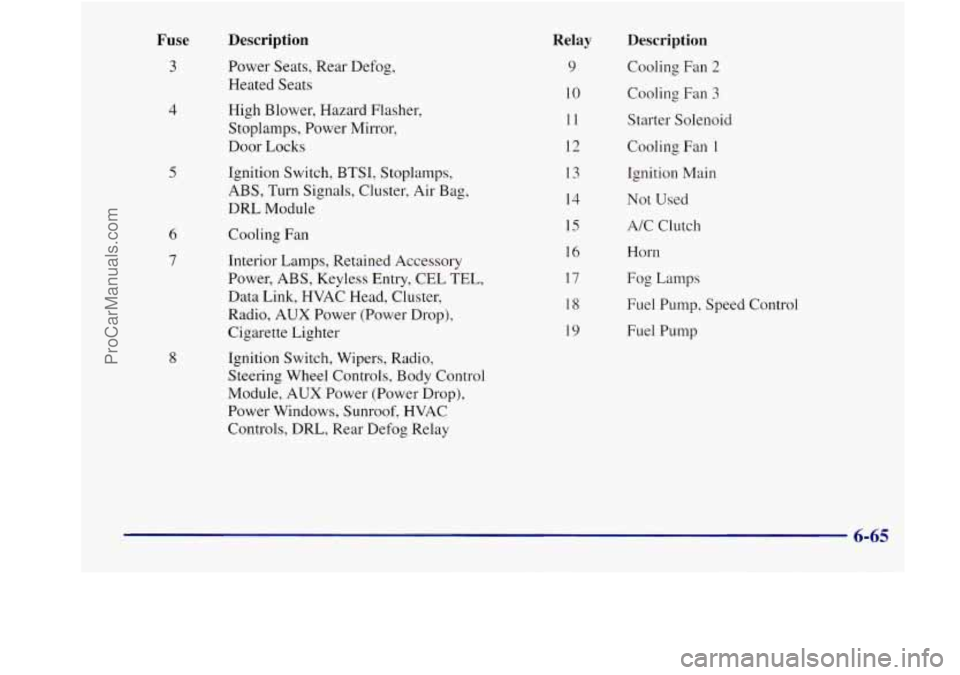
Fuse
3
4
5
6
7
8
Description
Power Seats, Rear Defog,
Heated Seats
High Blower, Hazard Flasher, Stoplamps, Power Mirror,
Door Locks
Ignition Switch, BTSI, Stoplamps,
ABS, Turn Signals, Cluster, Air Bag,
DRL Module
Cooling Fan
Interior Lamps, Retained Accessory
Power, ABS, Keyless Entry, CEL TEL,
Data Link, HVAC Head, Cluster,
Radio, AUX Power (Power Drop), Cigarette Lighter
Ignition Switch, Wipers, Radio,
Steering Wheel Controls, Body Control
Module, AUX Power (Power Drop),
Power Windows, Sunroof, HVAC
Controls, DRL, Rear Defog Relay
Relay
9
10
11
12
13
14
15
16
17
18
19
Description
Cooling Fan 2
Cooling Fan 3
Starter Solenoid
Cooling Fan
1
Ignition Main
Not Used
A/C Clutch
Horn
Fog Lamps
Fuel Pump, Speed Control
Fuel Pump
6-65
ProCarManuals.com
Page 383 of 388
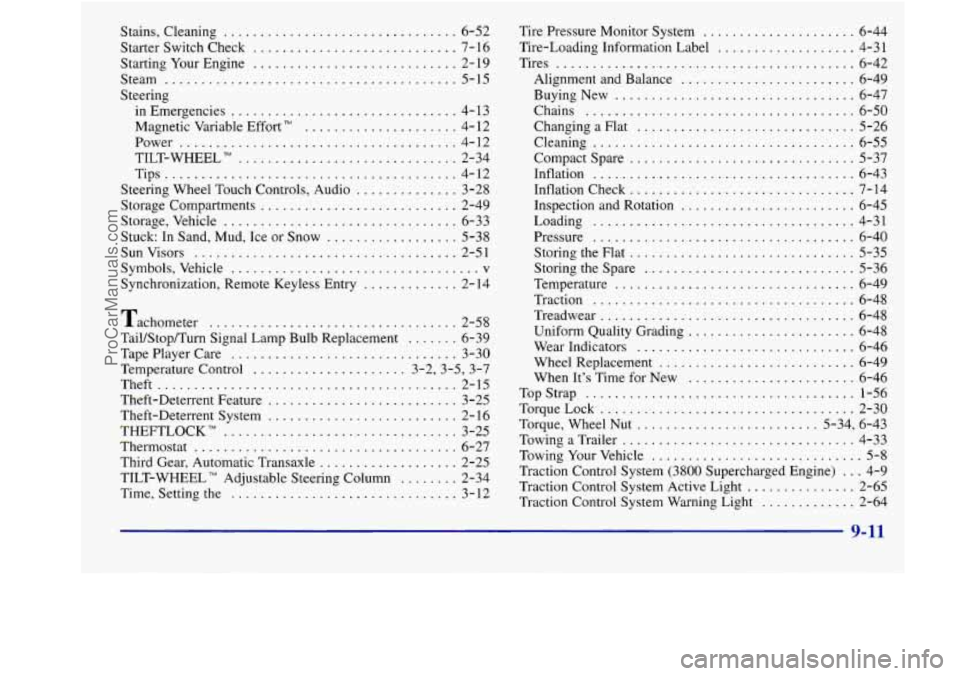
Stains. Cleaning ................................ 6-52
Starter Switch Check
............................ 7-16
Starting Your Engine ............................ 2- 19
Steam
........................................ 5-15
Steering in Emergencies
............................... 4- 13
Magnetic Variable Effort ” ..................... 4- 12
Power ...................................... 4-12
TILT-WHEEL”
.............................. 2-34
Tips
........................................ 4-12
Steering Wheel Touch Controls. Audio
.............. 3-28
Storage Compartments
........................... 2-49
Storage. Vehicle
................................ 6-33
Stuck: In Sand. Mud. Ice or Snow
.................. 5-38
Sunvisors
.................................... 2-51
Symbols. Vehicle
.................................. v
Synchronization. Remote Keyless Entry ............. 2- 14
Tachometer .................................. 2-58
Tail/Stop/Turn Signal Lamp
Bulb Replacement ....... 6-39
TapePlayerCare
............................... 3-30
Temperature Control
..................... 3.2.3-5. 3-7
Theft
......................................... 2-15
Theft-Deterrent Feature
.......................... 3-25
Theft-Deterrent System
.......................... 2- 16
Thermostat
.................................... 6-27
Third Gear. Automatic Transaxle
................... 2-25
Time. Setting the
............................... 3- 12
THEFTLOCK TM ................................ 3-25
TILT-WHEELTM Adjustable Steering Column
........ 2-34 Tire Pressure Monitor System
..................... 6-44
Tire-Loading Information Label
................... 4-31
Tires
......................................... 6-42
Alignment and Balance
........................ 6-49
BuyingNew
................................. 6-47
Chains
..................................... 6-50
Changing
a Flat .............................. 5-26
Cleaning
.................................... 6-55
Compact Spare
............................... 5-37
Inflation
.................................... 6-43
Inflation Check
............................... 7-14
Inspection and Rotation
........................ 6-45
Loading
.................................... 4-31
Pressure
.................................... 6-40
Storing the Flat
............................... 5-35
Storing the Spare ............................. 5-36
Temperature
................................. 6-49
Traction
.................................... 6-48
Treadwear
................................... 6-48
Uniform Quality Grading
....................... 6-48
Wear Indicators
.............................. 6-46
Wheel Replacement
........................... 6-49
When It’s Time for New
....................... 6-46
TopStrap
..................................... 1-56
TorqueLock
................................... 2-30
Torque. Wheel Nut
......................... 5-34. 6.43
Towing a Trailer
................................ 4-33
Towing Your Vehicle
............................. 5-8
Traction Control System (3800 Supercharged Engine) ... 4-9
Traction Control System Active Light
............... 2-65
Traction Control System Warning Light
............. 2-64
9-11
ProCarManuals.com